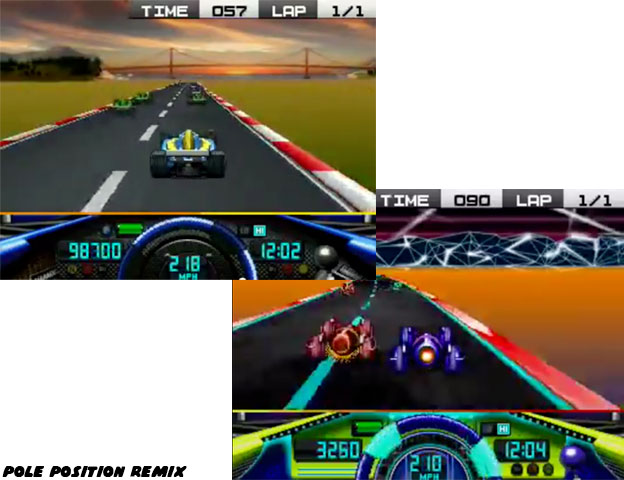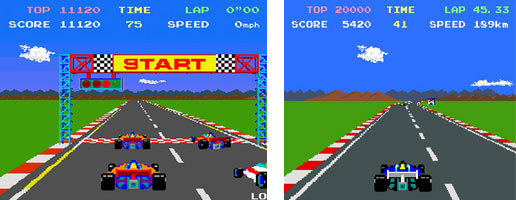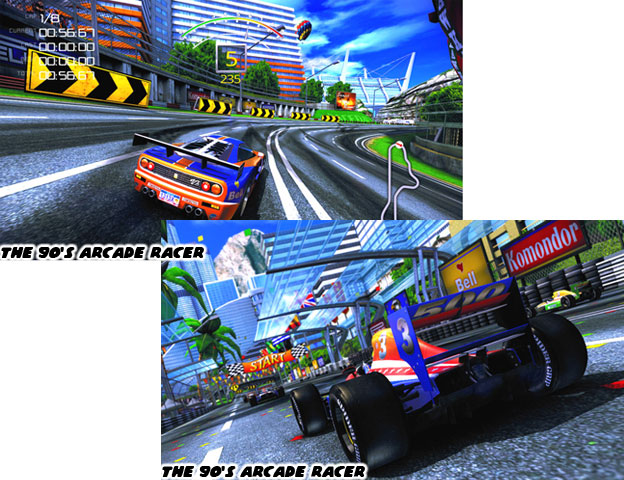Namco became aware of the popularity of retro-inspired remakes one the past few years. Despite a strong opening in the early '90s they had failed to topple Sega by the end of the decade. The studio came back in the new century looking to expand their market base in new media. Nothing in the past few years had grown as rapidly as social networking games and mobile titles. Young developers had a chance to create a breakout hit like certain Angry Flappy Birds. A great mobile game could make millionaires out of independent developers overnight. A big studio like Namco, and more recently Nintendo, had a lot to gain by remaking arcade classics for mobile devices. Mobile games tended to work best when players only had a few minutes to spare and games could be enjoyed in short bursts. Many arcade games were perfect in this regard. Pole Position Remix was released in 2008 to iOS devices like the iPhone, iPod Touch and iPad. It had garnered great reviews from editors and players alike. It was an iconic series and audiences had great expectations. Namco did not disappoint. The game was easy to get into and enjoy. Despite being on a smaller mobile device the graphics and sound was far superior to any prior Pole Position and even Final Lap arcade release. Thank goodness for advances in technology! Namco gave audiences more than they expected. The game included all the classic tracks including the renamed Namco track (Fuji), Speedway (oval), Wonder (Suzuka), Seaside (Long Beach) and the new Misaki Point.. There were also all sorts of items that could be unlocked.

Namco allowed players to earn skins to change the look but not control of the racers. If players wanted to see what the racers looked like on an alien planet they could choose a theme that turned the F1 races into alien ships. Even the scenery and rival cars were changed to complete the theme. Namco made sure to give the title the same TLC that their original arcade hits had. The music, control and design were impeccable. The game was a bargain for the price especially considering how much content Namco put into it. To be fair the company certainly got far more than 99 cents out of me when the original Pole Position was in the arcade. Long time fans were happy to see Namco returning to their roots. If the studio kept up the momentum then they could find tremendous success on the various mobile platforms.

When people said that they grew up in the arcade they were often serious about it taking up the majority of their childhood. For my brothers and I it was no different. We knew where all the good games were and were on many as soon as they were released. It seemed that there was not one mall, laundromat, convenience store or restaurant within a 40 mile radius of Long Beach where we did not know what arcade machines they had. A visit to a new mall was often met with great enthusiasm because it also meant that we would get to discover a new arcade in the process. The amount of time and money we spent in the arcades was substantial. The arcade experience certainly did define our childhoods. Of course it also defined an era for millions of kids in the US and abroad. Many went into the game industry themselves because they had such enjoyable memories while growing up. I knew that I was not the only racing fan that was affected by the majesty of the tracks featured in the Sega titles. Two fans Antonis Pelekanos and Tyrone Rodriguez started up a
Kickstarter Campaign to help fund his game project. The
90's Arcade Racer was an homage to the great racing games of the '90s. The creators cited the Sega and Namco racers as his biggest inspiration. The track layouts, details and even cars he selected were an amalgamation of Daytona USA, Ridge Racer and SCUD Race.

Every turn featured on the demo race course featured a jaw dropping spectacle to drive past, under or through. The skyscrapers, glass sea wall from SCUD Race were the most obvious but
throw in a large animatronic dinosaur head, rocket ship and six story astronaut balloon and the stages became as over-the-top as arcade visitors remember them. Mr. Pelekanos and Mr. Rodriguez had clearly been doing their homework. Copying an old racing game would be one thing but recreating the look and feel that the designers at Sega and Namco had spent the better part of two decades perfecting was brilliant. Based on the development diaries the selection of vehicle types and course details audiences would be having a severe case of deja vu for a game that never really existed. The 90's Arcade Racer would be nothing without impeccable track layouts. Sega wrote the book on level design and every developer big and small has had to study their work over the past two decades. The next blog will look at just a few chapters in their amazing legacy.
As always if you would like to sponsor me
please visit my Patreon page and consider donating each month, even as little as $1 would help make better blogs and even podcasts!






Very interesting both Pole Position Remix and 90's arcade racer.
ReplyDelete